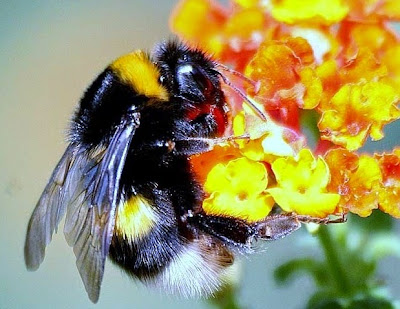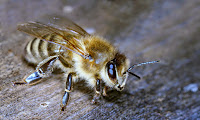There are over 20,000 species of bee found globally and what may surprise you is from that number only seven species of them are what are classed as honeybees furthermore, most colonies that are found consist of one main species in particular Apis mellifera as shown below. The picture above shows a bumblebee a common garden visitor of which they are roughly 250 species and alike honeybees form social structures consisting of a queen and her worker drones; these are often all female which communicate via emitting pheromones (scents) and waggle dancing which aids in directing colony members to new nectar site by a series of waggle like movements, providing the direction in relation to the position of the sun.
However this only describes a small amount of the various types of bees known, what about all the others?
Not everyone lives in hives
Some bees like to live in vegetation such as the bramble home of the species called Ceratina cyanea whilst, leaf cutter bees such as Megachile centuncularis cut circular pieces from leaves to line their nests. Other species of bee like to form nests underground, such as the tawny mining bee (Andrena fulva) or Lasioglossum malachurum who are often found nesting on footpaths. The red mason bee (Osmia
bicornis) found across Europe and Asia excavates holes in bricks in order to build nests, the females have horn like projections on their heads which aid in excavating the holes. A more unusual approach is seen in Osmia bicolor, this species nests in empty snail shells and will cover them with vegetation to camouflage them from predators.
 |
| Ceratina cyanea |
 |
| Megachile centuncularis |
 |
| Andrena fulva |
 |
| Lasioglossum malachurum |
 |
| Osmia bicornis |
 |
| Osmia bicolor |
A specific diet
All adult bees consume nectar, this is because upon reaching adulthood the adult bees only need to meet their energy requirements which nectar suffices just nicely. Bee larvae on the other hand need a source of protein to be able to grow and develop into adult bees therefore, female solitary bees collect pollen and place it with the egg within a nest cell before sealing it.
Some bee species are picky about which flowers they will obtain nectar from for example, Macropis europaea only visits one species of flower called yellow loosestrife; the bee not only collects pollen from the plant but also fatty floral oils, presenting it to the larvae alongside the pollen.Chelostoma campanularum as its name suggests will only visit flowers which belong to the Campanula genus where, the males can be found sleeping in the flowers.
 |
| Macropis europaea |
 |
| Chelostoma campanularum |
Sweat bees
Some bees that are classed as solitary are not living as solitary lives as to be expected and in some parts of the world are known as sweat bees due to the some species appearing to enjoy licking sweat off humans. Some of these species are social whilst others vary between social and solitary lives such as Halictus rubicundus which varies its behavior according to climate, being more social in warmer areas and solitary in colder ones. This group also contains some of the smallest bees in the world and some of the most beautiful, Lasioglossum morio is only 5-6mm in size but has a beautiful metallic green coloration which unfortunately is often overlooked as it looks colorless from afar.
To read the original article click here.
 |
| Halictus rubicundus |
 | |
| Lasioglossum morio |
I have found a bee in distress what do I do?
I often find a few bees during the warmer months that are on the floor crawling around and appear to be struggling to fly. As bees are currently declining across the UK and other areas of the world I always want to do my part to help get these poor bees back to good health again but how? A very much tried and tested technique that was passed down to me by my grandpa, is to get a little bit of honey and place it near to the bee and then back away and wait (sometimes its quick others it can take a while) the bee benefits from a energy boosting meal and will eventually fly away. Have not got any honey available to use? Agave nectar or even sugared water (2 tablespoons of sugar 1 tablespoon of water) can help to save a stranded bee.
My views
Bees are amazing insects that have adapted to many different ways of living in a variety of environments and with out them flower populations would suffer, as a major pollinator would be no longer available. As humans we rely on them to fertilize our crops/make our gardens beautiful via pollination and to provide us with honey therefore, maybe we should take just a little more time to appreciate and help/encourage bees into our gardens, if you would like to help/encourage more bees to visit your garden here are some helpful tips.
They are also lots of helpful websites with plenty of information available online, such as bumblebee conservation trust which features: identification charts, how you can help and even bumble kids so the younger generation can get involved. To visit the site click here.
As always thank you for taking the time to visit and read my blog, feel free to share your thoughts in the comment box below, perhaps you have some tips on how to encourage bees you may like to share or some other helpful websites. Until next time keep it wild!




No comments:
Post a Comment